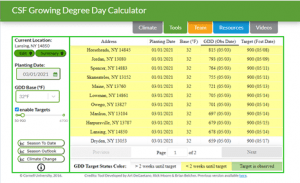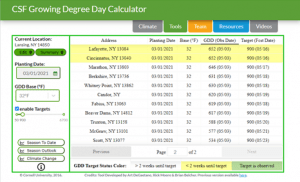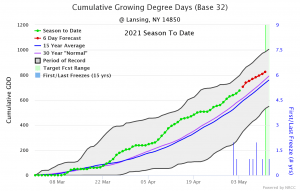This is the SCNY Team’s first full week of monitoring alfalfa heights for first cutting quality in 2021. A full report for the six-county region can be found in the following link: Alfalfa Height Reporting Sheet 5.4.2021
Why Use Alfalfa Height for Prediction?
We utilize alfalfa heights for targeting peak quality of all fields, as research as shown it to be the best indicator of peak quality.
As a reminder, for prediction of NDF content, the height of alfalfa as an indicator is as follows:
- 100% grass stands – cut when nearby alfalfa is 14 inches tall (achieves 50% NDF)
- 50/50 grass/alfalfa stands – cut when nearby alfalfa is 22 inches tall (achieves 44% NDF)
- 100% alfalfa stands – cut when alfalfa is 28 inches tall (achieve 40% NDF)

Predicted days to cut are based on daily NDF increases for grasses of 1.0% point, 50/50 mixed alfalfa/grass stands of 0.8% points, and alfalfa of 0.5% points and are adjusted for the coming week’s weather. Typically NDF increases about 0.8 to 1.2 per day for grasses, with cooler weather being the lower end of the range and warmer weather being the higher end. For alfalfa, NDF increases about 0.4 to 0.7 per day, also dependent upon warm/cool weather.
This Year is not 2020!
There are many locations that are quickly approaching or have approached target quality for all grass fields! Because our region is so varied, make sure you check out both location and elevation for your fields, but better yet, get out and check your own fields!
As per usual, our southern counties of Chemung, Tioga and southern Broome are well on their way with alfalfa growth. Again this year, the pocket of lower elevation fields in northern Onondaga are also showing substantial alfalfa growth early. These locations are averaging 14-15″, with some heights above 17″ indicating that grass has approached peak quality there. With lots of rain in the past few days, many fields are quite soggy and decisions should be made about harvesting grass for dairy quality, or letting it mature to not tear up fields and focusing on higher legume content fields for peak quality. In locations that have shorter alfalfa heights, grass still has a ways to go and decisions don’t have to be made quite yet. As always, heat will rapidly change the growing crop!
Consider a Dynamic Harvest Schedule
Know your forage targets! Joe Lawrence discusses using Dynamic Harvesting to capture the best quality in the right timing and can help you sequence harvest of your fields.
What quantity of forages is need for different groups of animals on the farm (quality x quantity)?
What opportunities does first cutting most realistically present for achieving these targets?
Answering these questions is key to determining harvest timing and sequencing fields. As discussed in Dynamic Harvest Scheduling the best results can come from being flexible in your harvest sequence and targeting fields when the forage is at the target quality regardless of factors such as grass vs. legume, location, etc.
With the unique spring weather patterns this year, there are likely scenarios where fields are not accessible when the forage is at target maturity. As these fields become over mature set them aside (they likely still have value for non-lactating animals) and focus efforts on harvesting fields that are at target quality.
Fully capitalizing on these forages of different quality also involves storing them in a way that allows for targeted feeding as discussed here.
A Brief Look at Growing Degree Days
If you’ve been following the team’s Friday updates, you’ll know I like to watch GDD by location to help tell the story of what we’re experiencing early on. Cornell’s Climate Smart Farming tool (www.climatesmartfarming.org) can be utilized to determine GDD by location. For grass determination, I selected base 32, and inputted several locations across our region. Alfalfa height is the best determinant for harvest of all grass fields, but it should line up somewhere around 900 GDD (B32). The friday updates have been using a target of 800 GDD for harvesting cover crops, so please be aware that this target has changed to 900 for grass harvest prediction! The tool gives accumulated GDD by location, and shows that many locations have grass ready for harvest now to May 8th, but there are some locations lagging that show 5/20 before they achieve 900 GDD. This echoes what the alfalfa height report says for early harvest and gives a date to those locations that are still too early to tell from alfalfa height. It also reminds us to be diligent about verifying conditions at our own locations. We will monitor this tool, as well as our height predictor report, to target peak quality for both grasses and alfalfa.
A Closer Look at Lansing, NY
Lansing, like many locations, continues to be about 100 GDD (B32) above “normal”. Cooler weather in the coming week shows a prediction closer to average GDD accumulation. It’s still early May, and weather is so unpredictable!
Next Report …
Look for our next report of monitoring heights to come out on Wednesday, May 12th. In the meanwhile, if you can’t get out to check your fields, call one of us on the team. We’ll be glad to help out.

Donette Griffith, Liz Alexander, Dana Havas, Jenny Smith, Dave Skeval, Mary Kate MacKenzie & Fay Benson
THANK YOU!



